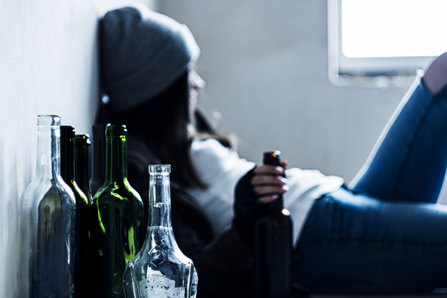The 80–20 Trap: How Drug and Alcohol Industries Prey on Their Heaviest Users

It is a well-known rule of thumb in business: 80% of your sales come from 20% of your clients. It applies to hardware stores, new car sales and designer clothing sales. It also applies to the subject of drug abuse, excessive drinking and addiction.
To succeed in business, you want to identify the most prolific 20% of clients and encourage them to continue to purchase from you. The same phenomenon is in effect in the world of alcohol and drug sales. While the exact proportions may vary slightly, it is obvious that a small number of drinkers and drug users will always be the heaviest customers.
Prevention Messages Are Likely to Be Ineffective
Once established as heavy users, these individuals are likely to be much less responsive to drug prevention/education measures than those who are light or occasional users. Once they become “loyal” customers (addicted), they have a hard time changing their habits. Their very bodies resist their efforts to change. They have become part of the 20% that will consume 80% of the products sold by a bar, liquor store, marijuana dispensary or street dealer.
It’s not a person who has a cocktail on Friday night or someone who smokes pot only on vacation that has the greatest need to hear a message about sobriety or rehab. It’s the 20% or so representing the heaviest drinkers and those drug users who are being controlled by their cravings. Chances are pretty good that any message from community groups, churches or even their loved ones will fall on deaf ears unless that message is accompanied by a stay at an effective drug or alcohol rehab.
Addiction Traps the Twenty Percent

Drug and alcohol abuse is an entirely different activity than usual retail sales businesses. In retail sales, a compulsive shoe shopper may go broke but otherwise, their entrapment in a pattern of buying designer footwear is minimally dangerous. With drugs or alcohol, there is often a chance of overdose death, even from alcohol. There is also a very long list of drug or alcohol-related illnesses that include cancer, heart disease, liver failure, diabetes and endocarditis.
There is also the trap of addiction itself. When a person loses control of their drug use, it’s like the drugs are doing the thinking for the person. They lose their integrity and ability to think rationally in this and many other areas. One of the great burdens many addicted people must overcome once they are in rehab is the fact that they valued their ability to get high or drunk more than they valued their families. Anyone who has worked with the addicted knows that no one willingly yields their love for their families. The drugs or drinks are thieves that steal that person’s ability to care for others.
How Well Does the 80–20 Rule Apply to Cannabis and Alcohol Users?
Let’s compare the number of past-year alcohol users and cannabis users with those struggling with substance use disorder, using statistics from 2021.
- Past-year marijuana users in the U.S.: 52,454,000
- Those using marijuana in a way associated with cannabis use disorder: 16,267,000
- Percentage: 31%
- Past-year alcohol users: 174,339,000
- Those using alcohol in a way associated with alcohol use disorder: 29,544,000
- Percentage: 17%
Average these two percentages and you get 24%.
Industry Leaders Know This Ratio Very Well
Both the legal and illegal substance industries are intimately aware of this datum. In fact, both industries cultivate effective methods of adding more people to the 20%. They also know that there will be some people that escape this 20% bracket, whether by death from overdose, substance abuse-caused illness or similar cause, or due to recovery. New victims must constantly be fed in on the other side.
So how do these two industries feed new people into this ruthless machine?
The Alcoholic Beverage Industry
The methods of acquiring new customers for alcoholic beverages largely involve money. The alcoholic beverage industry is expected to spend $7.7 billion on advertising in 2023. From this, they expect to take in $748 billion from sales. In addition to the usual media outlets for their ads, alcohol ads appear in grocery stores, sports stadiums, online, on the radio, on streaming music apps, in and between their users’ favorite shows (as ads and as on-screen alcohol use), and elsewhere.
One study found that youth aged 11 to 14 were exposed to an average of three alcohol ads per day; black and Hispanic youths’ exposure was roughly double that of white youths. What’s more, a 2018 survey of alcohol and tobacco being used in television shows revealed that in 180 shows that were frequently watched by adolescent males, alcohol was used 756 times and tobacco was used 49 times.
This is no accident.
The Cannabis Industry

The cannabis industry is growing incredibly fast. From $20.5 billion in 2020 sales, the industry is predicted to reach nearly $200 billion in 2028. Investors in this industry must find millions more customers to fuel that growth. Retailers advertise in print or in digital media. Cannabis use appears in television shows and movies. Advisors to the industry offer these suggestions for attracting new customers:
- Early-bird discounts
- Rewards programs for members
- Happy hour pricing
- First-time customer deals
- Daily specials
In other words, try anything that will bring new people into the business, whether the product is addictive or not. You might notice that some of these enticements follow the pattern of inducements offered by the alcoholic beverage industry. That’s by design. Cannabis entrepreneurs and investors are copying successful patterns from other industries to ensure they can add more people to their pool of heaviest users.
However, the National Institute on Drug Abuse estimates that 30% of marijuana users have some degree of marijuana use disorder (which matches the statistic above).
Studies of the addictiveness of this drug reveal that 9% of all those who use marijuana will become dependent on it. When the user is in their teens when they start, about 17% will become addicted.
Becoming One of the 20 Percent

When a person becomes addicted to either of these drugs, they become a customer that can’t say no. Therefore, they become one of the 20% of customers, the ones most valued by manufacturers and sellers because they keep coming back, over and over again, whether their use is harming them or not. Using a drug despite the harm that results is the very essence of addiction.
Sadly, the alcoholic beverage industry and the cannabis industry are not concerned about who becomes one of the 20% or becomes addicted. The game is about profits, not humanitarian activities.
Escaping From the Trap
Escaping this trap of being one of the 20% valued by the alcohol or cannabis industries very often requires a stay in an effective drug rehab. A person who is not able to quit on their own needs the support and monitoring of drug rehabilitation staff to enable them to stabilize their new sobriety. They need help, counseling and coaching as they build new sober living skills.
There must also be a way for this individual to overcome the guilt they feel after harming themselves and their families. They must recover the self-esteem they lost during their addiction. They must know how to deal successfully with upsets and setbacks in life that might send them back into alcohol or drug use.
Fortunately, it is possible to gain these skills and recover one’s integrity in an effective drug rehabilitation program. It doesn’t happen overnight, but a carefully chosen drug rehab program offers these improvements and many others.
Sources:
- Substance Abuse and Mental Health Services Administration. “Results from the 2021 National Survey on Drug Use and Health.” 2022, SAMHSA. 2022.
- Prevention Action Alliance. “How Alcohol Companies Target Young People.” PAA, 2023. PAA.
- Centers for Disease Control and Prevention. “Tobacco and Alcohol on Television: A Content Analysis of Male Adolescents’ Favorite Shows.” CDC, 2018. CDC.
- National Institute on Drug Abuse. “Is marijuana addictive?” NIDA, 2020. NIDA.


 ®
®